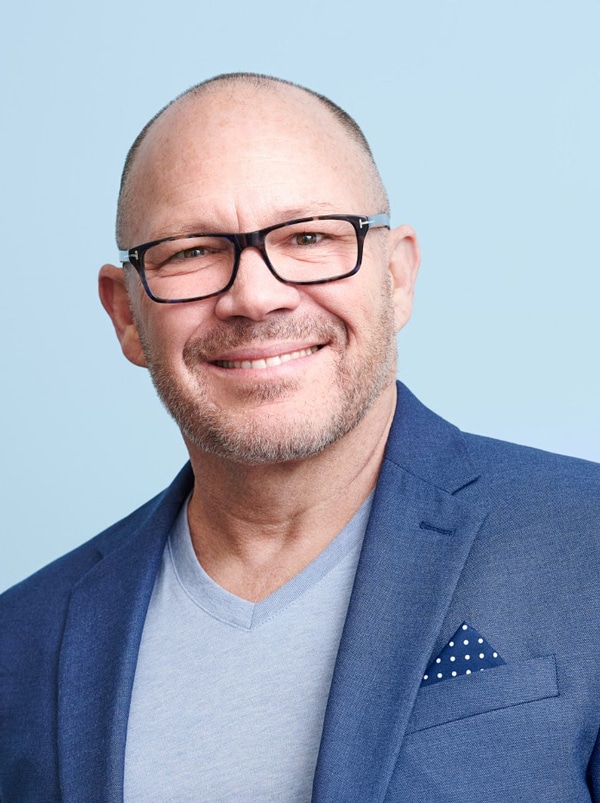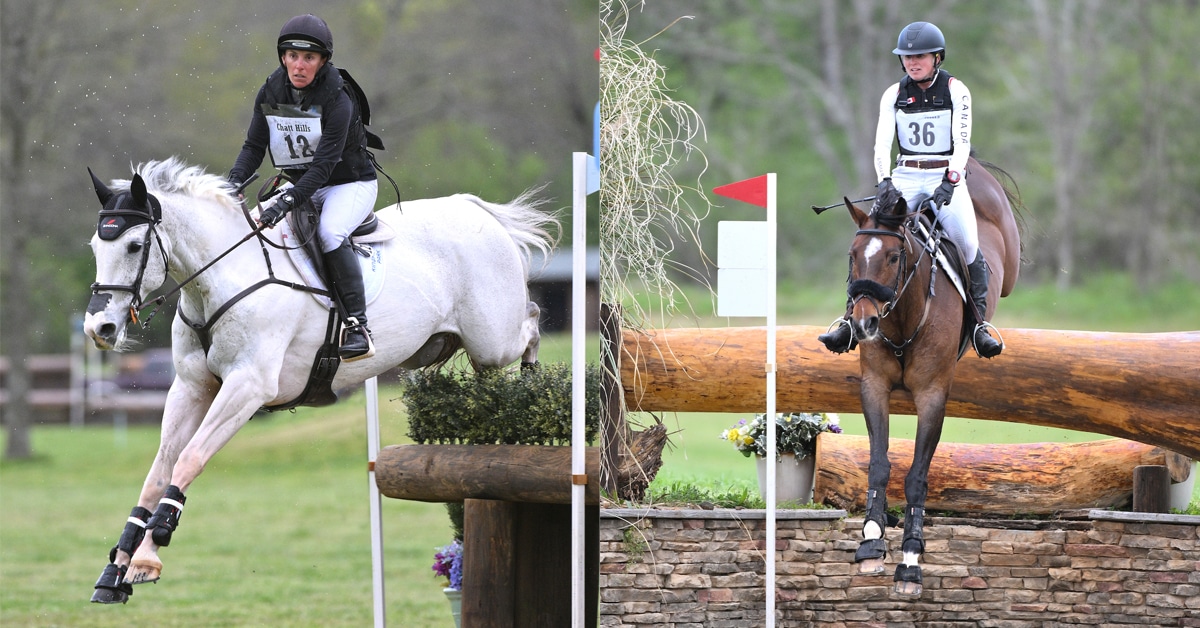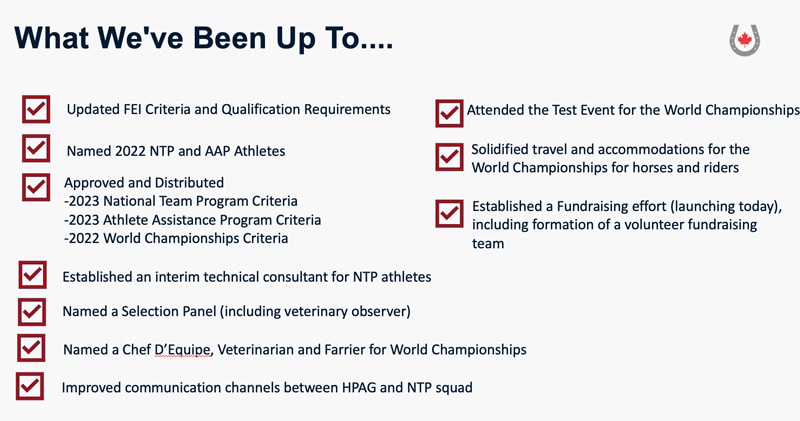For a very long time, management of the sport of eventing in Canada has been criticized for being disorganized, incohesive and even secretive. In late January, the Canadian Eventing High Performance Advisory Group was formed, consisting of the following individuals:
- Greg Paull (co-chair)
- Emily Gilbert (co-chair)
- Matt Ryan (also interim athlete advisor)
- Andy Bowles (also selection panel chair)
- Bruce Mandeville (also selector)
- Rebecca Howard (also selector, and future Chef D’Equipe)
- Shandiss McDonald (rider representative)
- Mike Winter (rider representative)
- James Hood (Director of High Performance)
- Fleur Tipton (Eventing Manager)

Emily Gilbert.
The group’s co-chair, Emily Gilbert, explains that the impetus for forming the new group (after a previous one had failed) was led by rider reps Mike Winter and Shandiss McDonald, who wanted to form a new body that is truly representative of the riders. In collaboration with Eventing Manager Fleur Tipton and James Hood, Director of High Performance, they put a call out for people who the riders felt would be “motivated, keen, and have the energy and expertise to basically restructure and reinvigorate the high performance program.”
Co-chair Greg Paull adds, “The group really came together and had to hit the ground running. We were already behind the eight ball with a number of things that should have happened last fall or before the beginning of the year, so we all came to the table with that same motivation. We have been gelling very quickly and working together very collaboratively to move things forward.”
The group’s mandate is straightforward: rebuilding the eventing High Performance program to position Canada to be able to compete on the world stage. “Our approach to this is putting out clear criteria so the riders know what is required of them, collaborating with the riders, providing opportunities for feedback – both ways – so it all continues to move forward,” says Emily. “Just being transparent about where we’re at, what we need to do, and how we’re going to get onto that world stage.”
She adds, “When we talk about building a team, that’s not just a team of three or four or five that go to a Games; it’s a team of owners, supporters, us, everybody being on the same page for the common goal of being recognized as leaders ‒ or up-and-coming leaders ‒ in the sport. So our mandate is really to provide the framework and start pushing that agenda forward in a cohesive way.”
“Communication is something that has been a challenge in the past,” admits Greg, “and we recognized that we needed to make that one of the first things that we improved upon. There are so many stakeholders within the sport that there has to be common ground to communicate what the plans are. Transparency and accountability has been our approach to everything that we have tackled.
“Emily and I went to many of the High Performance riders and we had one-on-one chats with everyone. We asked the same questions of every single one so that we could then take all of that information and gather a ‘big picture’ perspective.”
At the end of May the HPAG held the first of what is promised to be many more ‘town hall’ meetings via Zoom with all of the riders that are part of the High Performance program, their owners, supporters, and “anybody who wanted to be a part of it,” said Greg. “We made sure that people had an opportunity to ask questions about the different criteria – National Training Program criteria, athlete’s assistance criteria, World Championship criteria. And just basic questions about where we’re going with things in general.”
Participants were given “the Coles Notes of things that have changed, things that really matter in terms of planning, and what is going to change whether you’re on a development squad or a national team list. We tried to break that down in a way that was clear, concise, honest and transparent to the riders,” says Emily.
At that town hall, the HPAG presented attendees with a list entitled simply “What We’ve Been Up To”:
Canadian Olympic eventer Rebecca Howard, who has been based in England since 2012, has been named chef d’equipe for the Worlds; team veterinarian will be Dr. Alan Manning of Erin, ON, and Andy Vergut will handle farrier duties.
“We also had Rebecca Howard attend the test event in Pratoni, Italy for us,” says Emily. “One of the discussions we had at the town hall was, what does it look like? What’s the cross-country going to be like? What was the footing like, where’s the dressage? All of those logistical things. We’re also in the final stages of solidifying travel and accommodations for the World Championships.”
“We’re literally triaging things with an eye to making them better. Our number one priority was that we had these funds available through Sport Canada for carded athletes. So that had to get out to the athletes immediately.”

Greg Paull.
Greg says, “We have seen the budget and we’ve been working with EC to refine and shape that budget. So we’re fully on board knowing what our shortfall is. Because of the pandemic there have been financial challenges, so we have some ground to make up.”
In an effort to make up that shortfall, a huge fundraising push is underway. They have assembled a enthusiastic group of volunteers Emily describes as “from tech to corporate to super-keen event riders. We have a group now of almost 10 people in addition to ourselves who are helping drive that fundraising effort forward.”
One part of the three-tiered fundraising initiative is a strong social media presence. ‘Pony To Podium’ has been an EC mantra for a while, but HPAG has run with it in a compelling video campaign which shows how the top riders got started and shares their journeys (which are not paved with money and fancy horses, as the public might mistakenly believe).
“We’ve asked all of the High Performance riders to participate and we have these videos coming in now. They either talk about their entire pony-to-podium journey, or a segment of this journey, as a way to build awareness for the rest of the world to the horses and riders that are declared to compete for Canada,” explains Emily. The videos appear on the Canadian Eventing Team Instagram page and are also shared on the rider’s social pages. Accompanying each video is a QR code that takes you to a page where you can make a donation through the Canadian Olympic Foundation site. EC recently announced that Canadian owners and breeders residing in the UK, Kelly McCarthy-Maine and Shane Maine, are providing a substantial initial donation of $100,000 to kickstart the “Pratoni, Lets Go!” drive.
“We also have a ‘boots on the ground’ approach,” says Emily. “Our young riders as well as some of our volunteers are going to be dressed in what they call crazy Canadian gear – Canada flags and Canada shirts, Canada everything.” The crews will drum up support in the VIP tents, at the trailers and ingates and everywhere else at the shows. The third component will be to approach some larger corporate donors.
There is an online silent auction in the works, with products and services provided by riders. “We’re also really keen on getting bursaries in place so that if someone says, ‘I’m going to Badminton, I’m going to Burghley, and here’s who I’m going to train with’ that we have funds in place to go.”
“Right now, though, we are really just focused on sending a team of five to the World Championships because it’s our first chance to qualify for the Olympics. That’s where our priority has to be.”
The group had lengthy discussions about whether to send a team to the Championships. “We are trying to breathe new life into high performance eventing,” said Paull. “Fundamentally, in order for the riders to come together and build camaraderie they have to do it in practice and the first opportunity is to do it in September.”
“The top five teams in the world, according to Equiratings, are quite locked in in terms of consistency, but beyond that it’s quite variable in terms of team performance,” added Gilbert about the team’s chances. “We do have an opportunity if we have a solid team performance to qualify a team. That’s not based on a hope and a prayer, but based on the stats we’ve been given. This is a program where we are focused heavily on our riders which includes team experience. That’s an area where we need some practice. Plus, statistically we have a chance to qualify a team for Paris.
“It’s also part of a bigger vision to help us build the sport beyond the close future. If the team does qualify [for Paris], that gives us an opportunity to send other riders to get experience at Pan Ams, which helps build our depth. We know we have to build depth into the program because all competitive programs have depth. We really have thought this through and considered multiple stakeholders.”
Greg outlines the next steps. “Now it’s just a question of getting through all of the selection events, and then naming a team of up to five horses and riders as of August 1.” At Pratoni, the top seven teams will earn an Olympic berth (or eight if Olympic host France is one of the qualifiers). If Canada doesn’t qualify at Pratoni, the next opportunity would be the Pan American Games in Chile, where a top-two podium finish would be necessary.
Beyond Paris, HPAG will have it’s eyes on other major championships “and establishing that real level of ground support at international competitions,” he adds. “Whether team or individual competitions, we really want to create that team environment. That’s what other international teams are doing that we need to do. We need to set up a program so our Canadian riders are always supported ‒ not just every third or fourth year at a major championship.”
“Beyond the Games, Greg and I both really want to build a continuous program that is sustainable for eventing in Canada, support for grassroots and for young riders,” says Emily.
It’s easy to see the commitment, passion and momentum that is driving this effort – although it hasn’t always been easy. “Legitimately, some of the riders are skeptical, because there’s been a lot of turnover over the last period of time, but I think they’re seeing that we’re making progress, and it’s legit,” says Greg. “It’s going to take a little bit of time to build up that real level of trust.”


